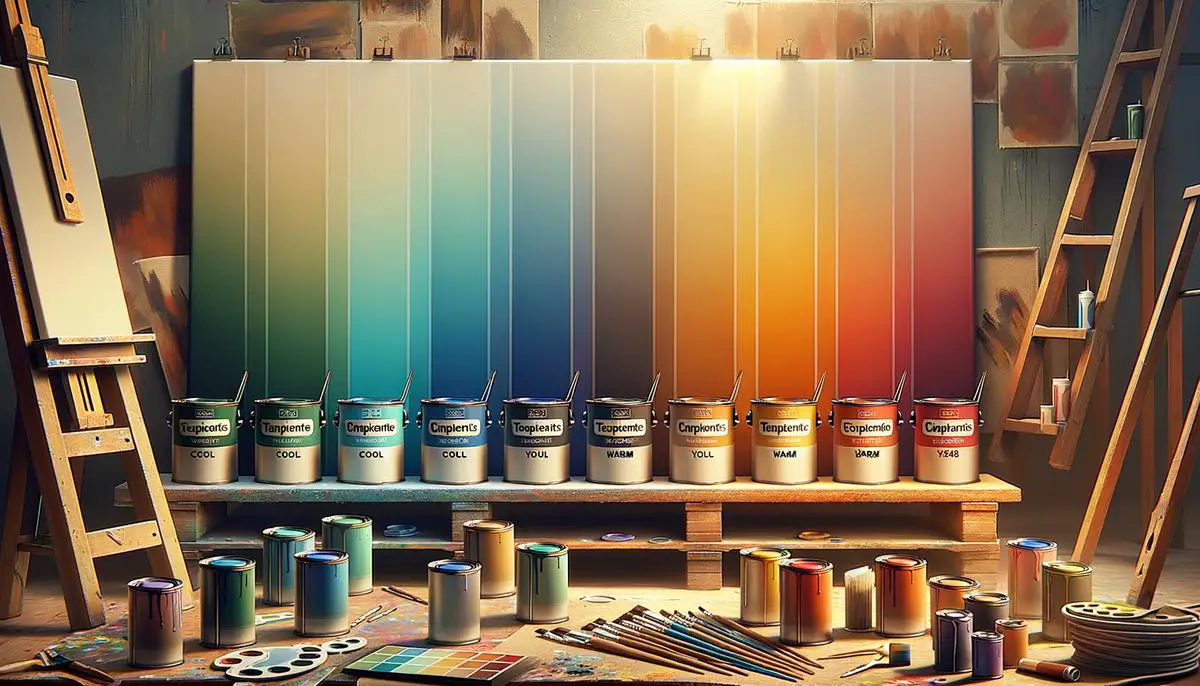Exterior Painting in Cold Weather: 15 Tips for Success

Painting your home or creating a piece of art is more than just choosing the right colors; it’s about understanding how the environment affects your work. Temperature plays a crucial role in how paint behaves, dries, and lasts over time. This article explores the significance of temperature in painting projects, offering insights into achieving the best results. By grasping these concepts, you can ensure that your effort leads to beautiful and enduring outcomes.
Understanding Paint’s Temperature Sensitivity
Painting your home or a piece of artwork can transform its appearance, but have you ever noticed how temperature can play a big role in how the paint dries and lasts? Let’s dive into why temperature is a key player in getting your painting project just right. Trust us, understanding this will save you a headache and ensure your hard work doesn’t go to waste!
Understanding the Importance of Temperature for Paint
When it comes to painting, not many think about the thermometer, but they should! Temperature affects paint at every stage, from application to drying, and even its long-term durability. Here’s why paying attention to the temperature is crucial for your next painting project:
- Ensuring Perfect Application: Ever noticed how paint becomes too thick or too runny? Temperature is often the culprit. Most paints are designed to be applied at moderate temperatures – typically between 50°F (10°C) and 90°F (32°C). Too cold, and your paint might not spread evenly, leaving ugly streaks. Too hot, and it may dry too quickly, not giving you enough time to work for a smooth finish.
- Achieving Optimal Drying Times: If you want your paint to dry just right – not too fast and not too slow – keeping an eye on the temperature is key. Cool temperatures can slow down the drying process, making the paint stay wet for longer than desired. This opens a window for dirt to stick or for the paint to get smudged. On the flip side, extreme heat can speed up drying too much, leading to cracks or peeling because the top layer dries out faster than the layers beneath.
- Securing Long-Lasting Results: Want your paint job to last? Temperature impacts this too. Painting in the ideal temperature range helps ensure the paint cures properly. Properly cured paint is more durable and resistant to weathering, fading, and other wear and tear. Ignoring temperature can lead to premature aging of your paintwork, meaning more touch-ups or a complete do-over sooner than you’d thought.
- Avoiding Unpleasant Surprises: Humidity pairs up with temperature to throw curveballs at your painting project. High humidity and low temperatures can result in condensation on freshly applied paint, leading to watermarks or even mold growth. Low humidity and high temperature can overly speed up drying. Keeping an eye on both ensures your paint goes on smoothly and stays beautiful.
Follow These Tips!
- Always check the paint can for the manufacturer’s recommended painting temperatures.
- Plan your project around the weather forecast, aiming for days that fall within the ideal temperature range.
- If painting indoors, use climate control to maintain an optimal painting environment.
Understanding the effect of temperature on paint can make all the difference in the outcome of your painting projects. With this knowledge in hand, you’re well on your way to achieving professional-looking results that will stand the test of time. Paint wisely!

Identifying the Minimum Exterior Painting Temperatures
Let’s Talk Temperature: Finding The Sweet Spot for Outdoor Painting
Ready to add a splash of color to your home’s exterior? Planning that DIY project requires a bit more than just picking the perfect hue. The secret ingredient? Temperature! That’s right, choosing the right day to paint can make or break your project. Let’s dive into the magic number for outdoor painting, ensuring those brush strokes lead to stunning, enduring finishes, rather than an artwork of regrets.
The Magic Temperature for Outdoor Painting:
Step 1: Meet the ideal range, 50°F to 90°F. Circle those calendars because temperatures play the leading role here. To nail the painting job, aim for a sweet spot between 50°F (10°C) and 90°F (32°C). Now, why is that so crucial? Dive in deeper.
Step 2: Why 50°F gets the spotlight. Holding up the low end, 50°F (10°C) isn’t just a random pick. Fall below this line, and you’ll find your paint not adhering properly – think patchy nightmares instead of serene landscapes. This temperature marks the point where most paints, especially latex and acrylic, promise to behave, smoothly transitioning from the can onto your wall without the drama.
Step 3: Early birds and night owls, take note. While landing within 50°F to 90°F is the big goal, timing’s your backstage pass to flawless application. Opt for painting during early hours or seek the cool embrace of late afternoon. These golden windows offer not just comfort but ensure the temperature doesn’t dive or peak unexpectedly. Think of it as syncing your paint’s rhythm with nature’s.
Step 4: A watchful eye on the thermometer. Got an eye for detail? Extending it towards a thermometer might just make it your project’s MVP. As you gear up or even halfway through painting, keep a close watch. Sudden drops below 50°F can send your project into a tailspin, with drying and adhesion waving goodbye.
Optional Tip:
Feeling edgy about unexpected cold snaps? Look for paint varieties tailored for cooler climates. Innovations have thrust paints that grip and settle down well, even a few notches below the traditional threshold.
Remember, that perfect painting day isn’t a myth. With the thermometer as your sidekick and the 50°F rule etched in mind, you’re set to transform outdoor spaces into canvases of joy, engaging not just in art but smart art. So, gear up and wait for that climate sweet spot — your masterpiece awaits under open skies.
Happy painting!

Optimal Weather Conditions for Exterior Painting
Selecting the Best Weather Conditions
Choose a Clear, Dry Day: Weather plays a crucial role when planning to paint, especially outside. Aim for a day predicted to be clear and dry. Moisture in the air, in any form—be it rain, fog, or heavy dew—can hinder paint’s ability to dry properly and evenly. Keep an eye on the weather forecast, and try to find a day with low humidity and no chance of precipitation.
Analyze Humidity Levels: Even if temperatures seem perfect, high humidity can be a hidden enemy of painting projects. It can cause paint to take much longer to dry and may even affect the finish, leaving you with less than satisfactory results. Seek a day when the humidity is below 50% for optimal drying conditions.
Avoid Strong Winds: Wind might seem like a benign factor, but it can contribute to dust and debris adhering to fresh paint or cause uneven drying. Particularly for outdoor jobs, strong breezes can also make it hard to control spray paint cans. Thus, a day with calm to light winds is your best bet.
Consider Sunlight Position: Direct sunlight can affect the paint’s temperature, potentially causing it to bubble or blister. When planning your painting day, try for a time when the area you’re going to paint will be in the shade. Painting under these conditions allows the paint to dry consistently, resulting in a smoother finish.
Check the Dew Point: The dew point indicates the temperature at which air becomes saturated with moisture and dew forms. Painting on a day when the temperature is less than 3 degrees above the dew point throughout your painting and drying period ensures that moisture won’t condense on your fresh paint.
By carefully selecting the appropriate day considering all the above factors—clear sky, low humidity, gentle breezes, and proper sunlight—you are setting up your painting project for success. These considerations ensure that from application to the final drying stages, your painting endeavor is achievable without any unwarranted interruptions or quality concerns.
Remember, good preparation isn’t just about the painting process itself; it also involves choosing the right time and conditions to obtain those professional-looking results we all crave.

As we’ve seen, temperature and weather conditions significantly influence painting projects’ success. By paying attention to these factors and planning accordingly, you can avoid common pitfalls that compromise paint application and durability.
Whether you’re sprucing up your home’s exterior or embarking on an artistic endeavor, remembering these tips will help you achieve professional-looking results that stand the test of time. Paint not just with colors but with knowledge, and watch as your projects transform into lasting masterpieces.
